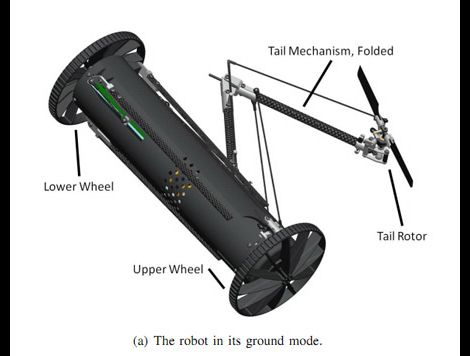
Let’s face it – building robust robots isn’t exactly easy. When designing them, builders often focus on a single method of locomotion in attempts to create a robust, reliable means of transportation. Whether it moves on the ground or in the air, there are always compromises to be made when designing a robot with the ability to travel over variable terrain. Looking to change that, researchers at the Center for Distributed Robotics have recently unveiled a robot that can travel on the ground with ease, then take to the skies in a matter of seconds.
The robot is rolls along the ground on a set of wheels mounted at either end. When it is time to fly, it pushes itself up onto one end before extending its rotors. As you can see in the video below, the transition occurs pretty quickly.
The current prototype is pretty fragile and carries quite the hefty price tag . More robust revisions are already in the works, so expect to see more in the coming months.
[Thanks Sandeep]
[youtube=http://www.youtube.com/watch?v=1JJzmfkufPE&w=470]














awwww how cute i want one too
The first transformer came to life in 2011. Its successors aligned themselves with Skynet the future became bleak for humans.
So even though this may be one small step in the elimination of human beings, it’s still pretty dang cool.
Why can’t you put wheels on a toy helicopter? I realize this is a different design, but what are the advantages? Get a toy helicopter add a small transmission that can select between the rotor and the driving wheels. Then couple a steering rear wheel with the tail rotor.
Now make one that can go under water, and then I will be impressed.
Also, it transforms a little too much. Look at the actual flight test. It has a landing base that wasn’t there during the driving portion, probably because the actual base is too narrow for reliable stable landings.
I see what you did there.
Bob:
it says that it has training gear on it
so i think they only put those on to allow it to land easier… not because it needs it
Take a look at the renders. Their prototype doesn’t fully transform. Note that the rotors in the flight test are locked out (probably by hand). As a proof of concept, I’d say they did pretty good.
If they get the bugs out, we’re looking at something that is smaller, easier to carry, requires little to no setup to deploy. A toy (or model electric) helicopter can probably do the same, and maybe even have higher payload, but I know I couldn’t simply sling one in a pack.
Bob: The version in the video is one of the old prototypes. The new designs now work on only two rotors instead of four, and fold up far more completely.
The newest revision is being assembled this summer, and resembles the renders much more closely. The actual mechanical design of this thing up close is one of the more impressive projects I’ve had the privilege to work on.
holy crap its a manhack
I’d be stepping back too. I think it would have sawn him off at the knees.
Nice work!
Quadcopter with wheels > This
Just sayin.
Not a robot, it’s a remote control toy. Call me when it flies it’s self, THEN it can be called a ROBOT.
looks like a futuristic lawn mower
It’s not a robot, it’s a RC device…
I’m just blow away that they built something that quote, “transitions into flight mode”
Dude, you roll out ANYTHING that you can really say THAT about and I know I’m gonna have to go for A fresh set of Aquaman underoos. Can’t speak for anyone else…
Holy crap, that’s “living the future” cool.
Well done folks.